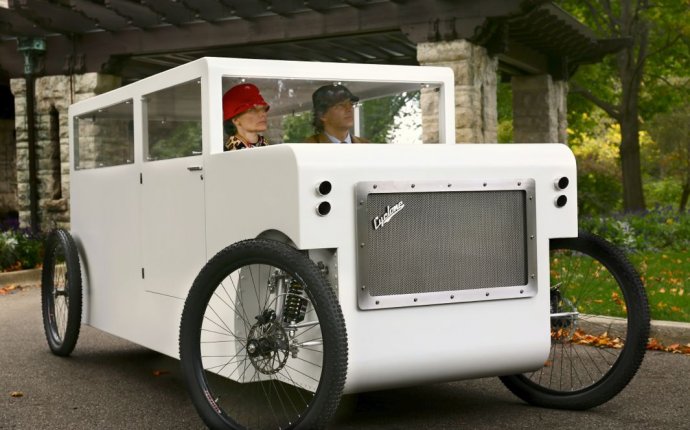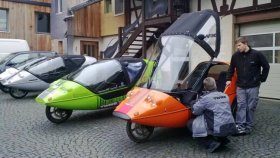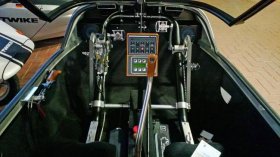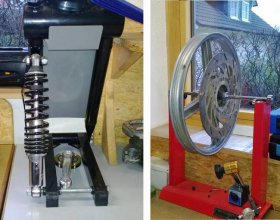
Human electric Hybrid Vehicle
 Search the internet for “human-electric hybrid” and you will see some prototypes of cars, and many attempts at powered bikes or enclosed scooters. But where is the dreamer’s sustainable vehicle: a weather-proof car that can carry two, compete with fossil-fueled traffic, and provide the opportunity to get a workout while extending our range?
Search the internet for “human-electric hybrid” and you will see some prototypes of cars, and many attempts at powered bikes or enclosed scooters. But where is the dreamer’s sustainable vehicle: a weather-proof car that can carry two, compete with fossil-fueled traffic, and provide the opportunity to get a workout while extending our range?
Would it surprise you to learn that there is one such vehicle on the market, available for sale today, street legal in Europe and North America? And that this vehicle is approaching 20 years of road-proven use by hundreds of sustainable-vehicle fans who have made the leap to a completely new lifestyle with a human-electric hybrid?
TWIKE sells the only human-electric hybrid currently mass-produced: vehicle number 1000 recently rolled off the assembly line. We visited the factory to get the answers to the existential questions regarding the future of human power in hybrid vehicles:
- What value does pedal-power add to a vehicle that must compete with traffic and over typical commuting distances?
- Is an HPV/EV hybrid the world's best city car?
- What are the challenges when you take a TWIKE on tour?
- What is the lowest cost per mile that can be hyper-miled out of a TWIKE?
- Can people improve their fitness with an HPV/EV Hybrid?
- Is there still a place for a 20-year old human-powered EV design in a world where Teslas command the "EV sportscar" headlines and most major car manufacturers have an EV on or coming to the market? And closely related, is the EV trend killing human-powered vehicles (HPVs)?
 Introduction to the TWIKE
Introduction to the TWIKE
TWIKE met its market for the first time at the 1986 Vancouver World Expo, winning the "functionality award" for best ergonomic design in the innovative vehicle design competition. The unique joystick control keeps legroom free for pedaling as the driver "floats" over the roadway on the single front wheel, earning TWIKE drivers the nickname "pilots". The company offers a training course, TWIKE to Fly, in which potential customers or adventurous vacationers can earn a TWIKE driver's license qualifying them to rent a TWIKE .
German engineering: TWIKE fulfills vehicle inspection standards.
The TWIKE was developed and produced initially in Switzerland, but production moved to Germany after the initial TWIKE investors became insolvent (2002) and a group of German importers joined together to purchase the equipment and continue TWIKE production under the company FINE Mobile.
 Twike's body withstands UV-radiation without deterioration.
Twike's body withstands UV-radiation without deterioration.
TWIKE lucked out a bit by adopting Luran-S for the body material. BASF was pitching the plastic for automotive applications due to the fact that it can be recycled to material of equal value to the starting plastic (no downcycling). It turns out the material has weathered the years well, proving highly UV-resistant so that even unpainted older models look as good as new.
Direct Drive Pedal Power
Wolfgang Möscheid explains the direct drive.
At the TWIKE factory, a group of dedicated individuals work at fulfilling a vision more than merely running a business. The person with whom we had contact was Wolfgang Möscheid, who (dare I say?) could be called the spiritual leader at TWIKE. A man who believes in what he does, the energy and conviction he contributes to TWIKE adds soul to the company, and animates him as he explains the pedal power concept used by TWIKE.
TWIKE's enclosed bike chain drive requires little maintenance.
Although there is talk of changing to a pedal-powered generator in future versions, the current TWIKE relies on direct drive pedal power. That means when you pedal, you feel connected to the motion of your vehicle, a motive force rather than a mere passenger.
But that feeling hides a dangerous illusion. This is no bike. Even two people could barely move it by pedal power alone. And as the TWIKE picks up speed in EV mode, you have to pedal harder to feel as though you are not spinning in the air. At such speeds, eventually you will break a sweat, requiring you to give up your precious gain in energy by turning on a ventilator fan to keep the windshield from fogging up.
TWIKE ventilators have recently been upgraded, newer on right.
World's Best City Car?
In fact, Möscheid enthuses that the best way to drive a TWIKE is to pedal just below a sweat-inducing speed. In the city, where cars can move barely faster than bicycle speed, the TWIKE finds its element. Driver and passenger arrive at their destination exhilarated but not stinky; range extends to up to 200 km (124 miles) at such lower speeds.













